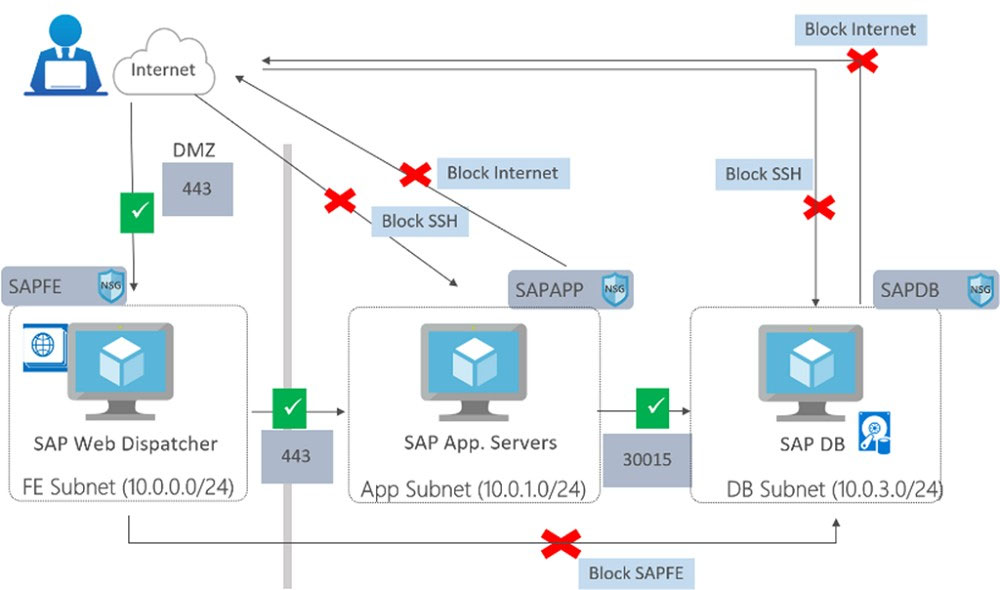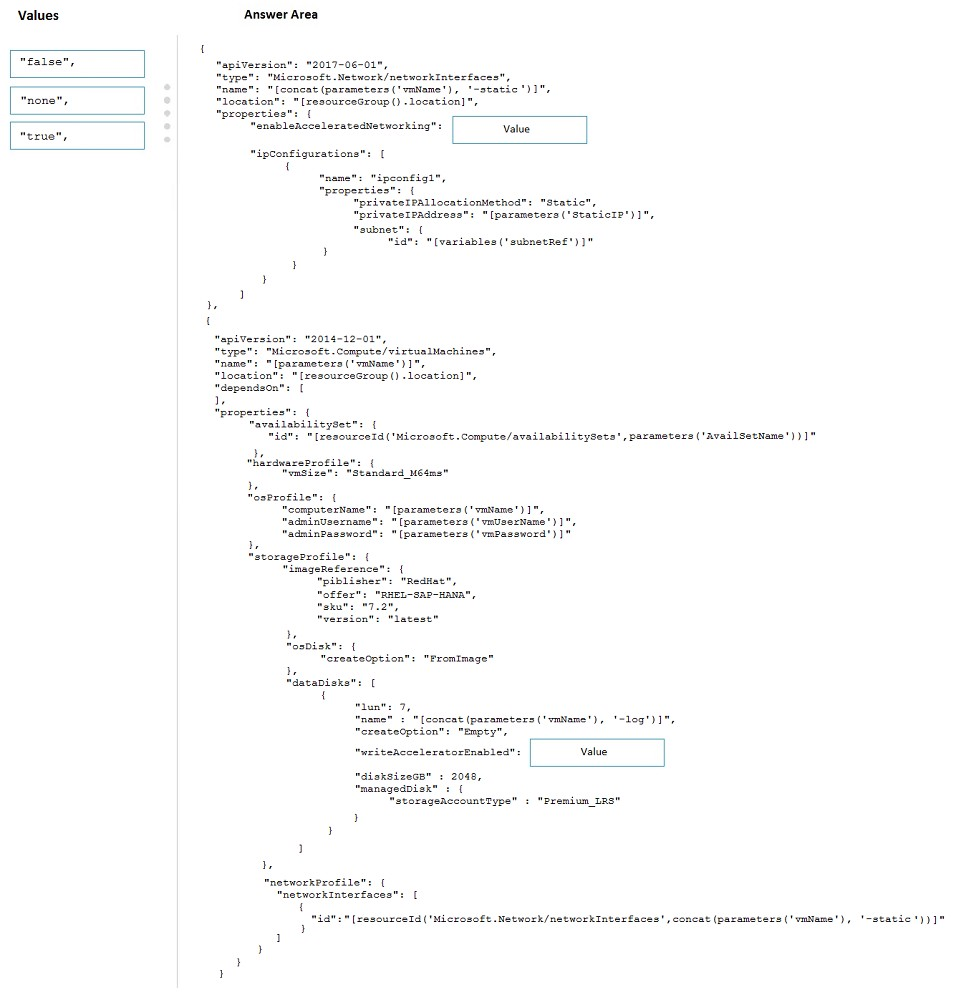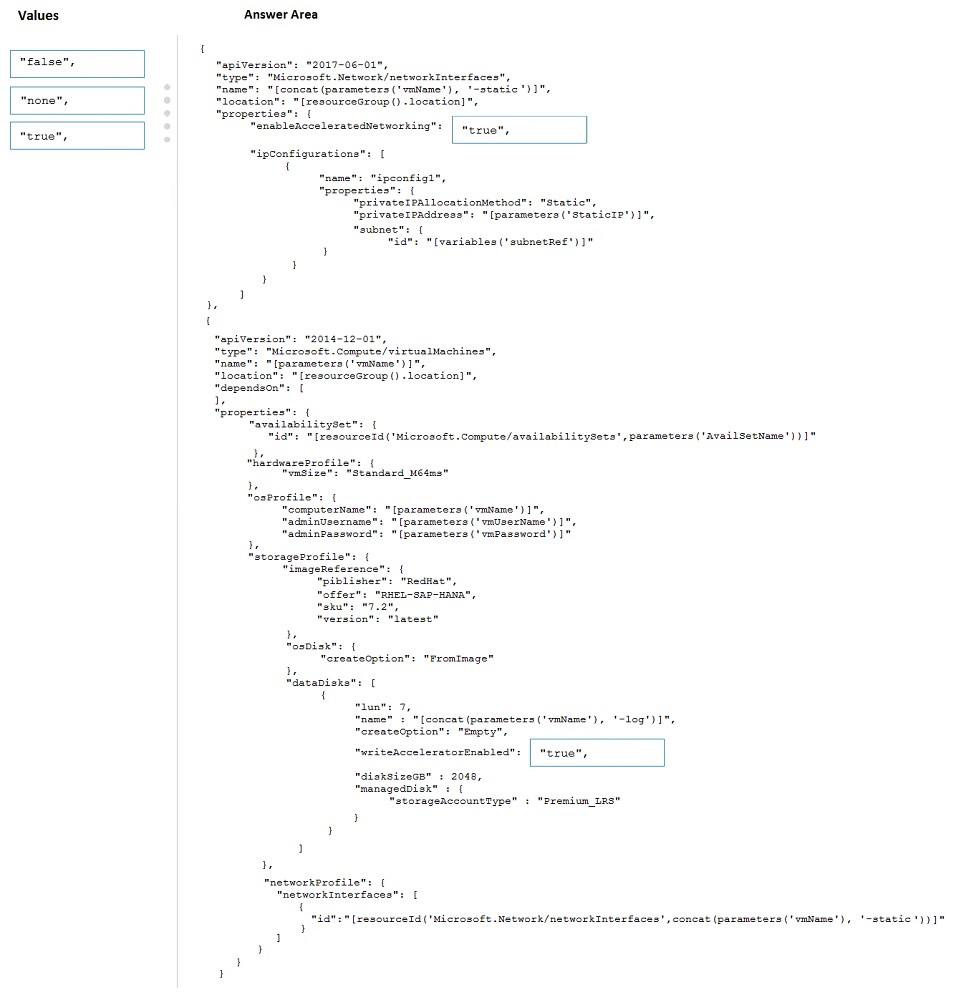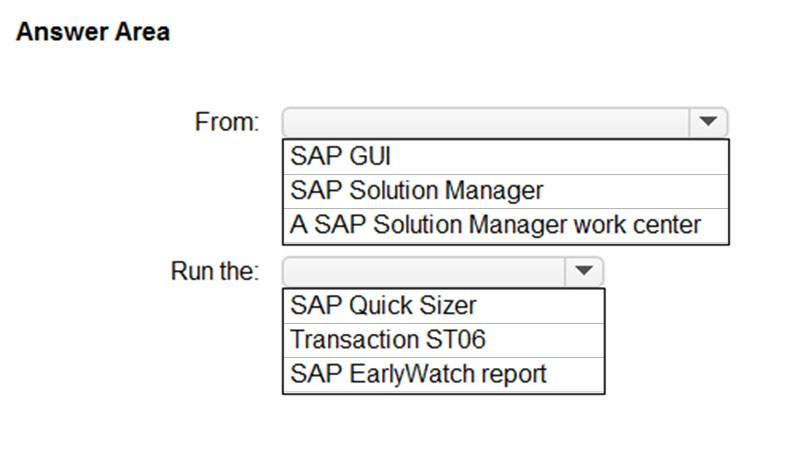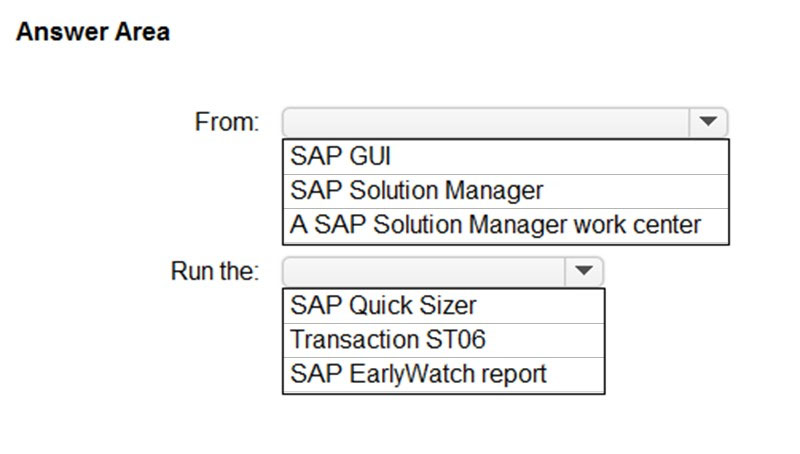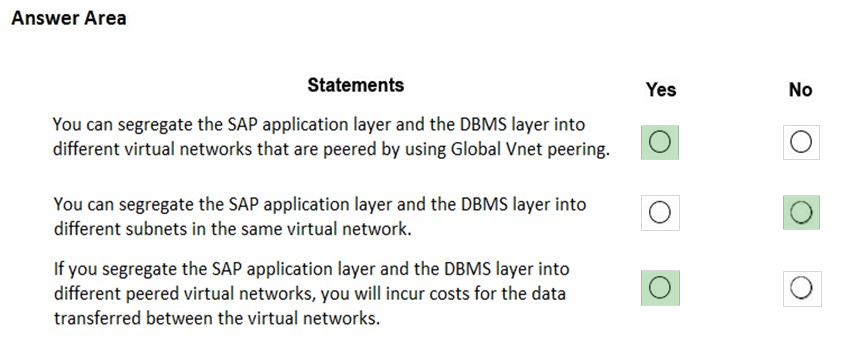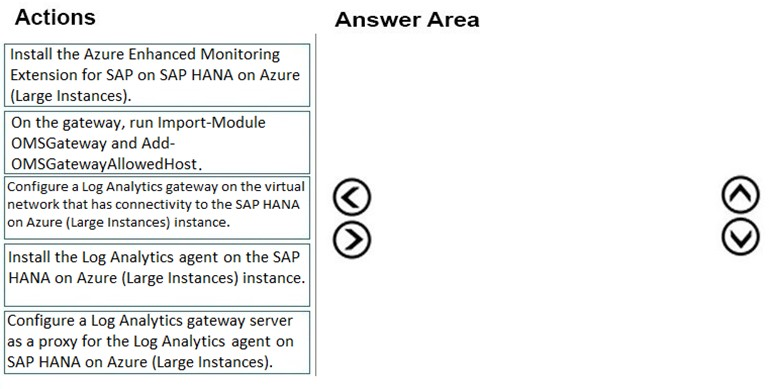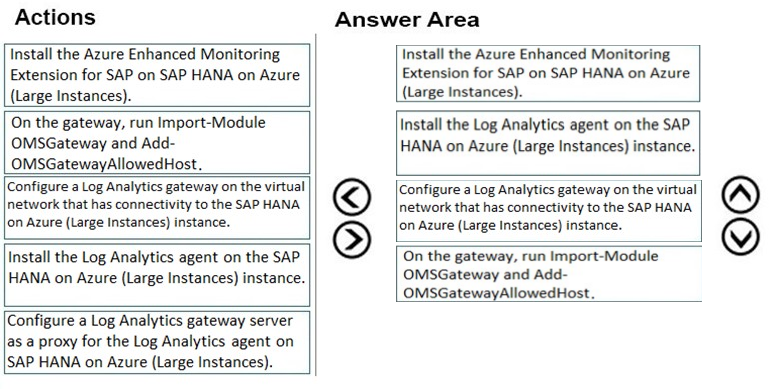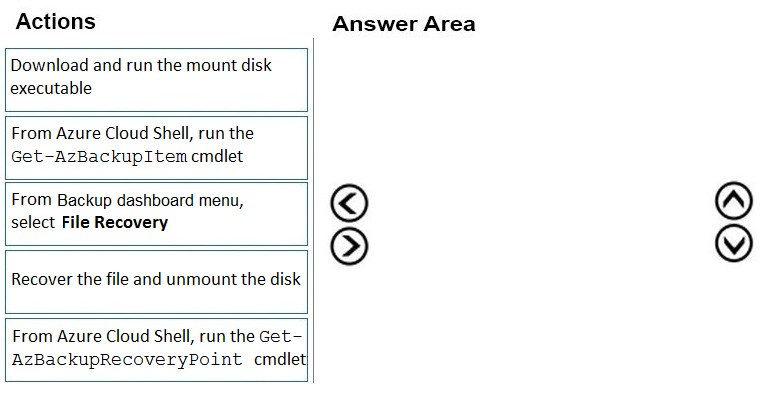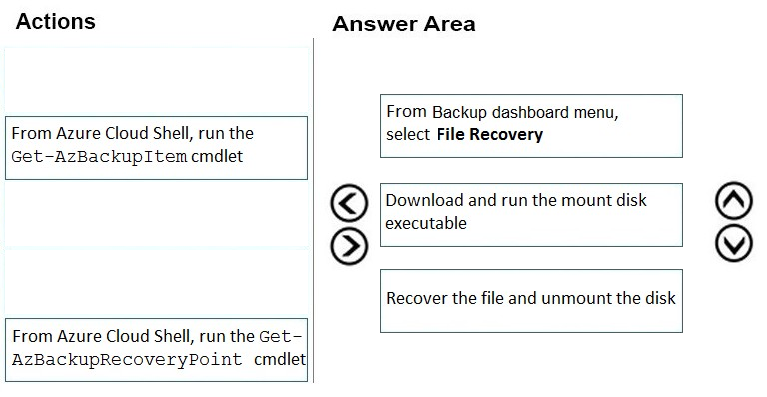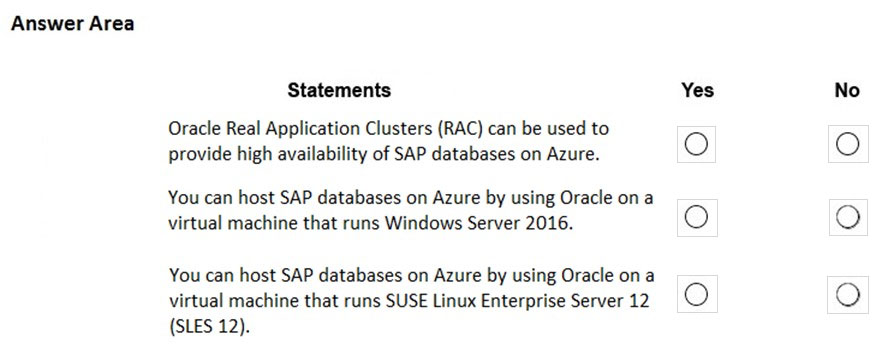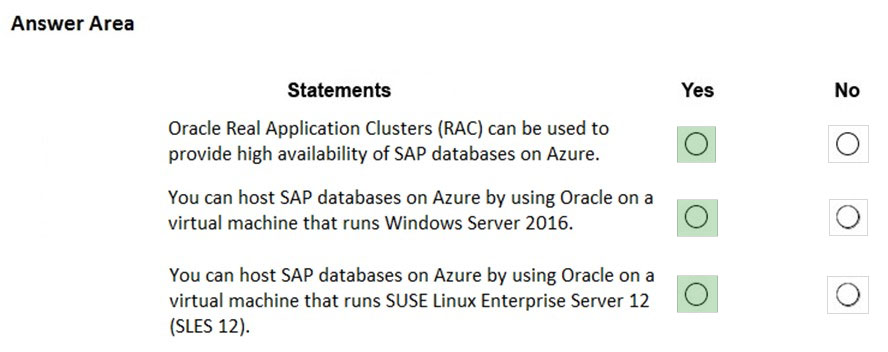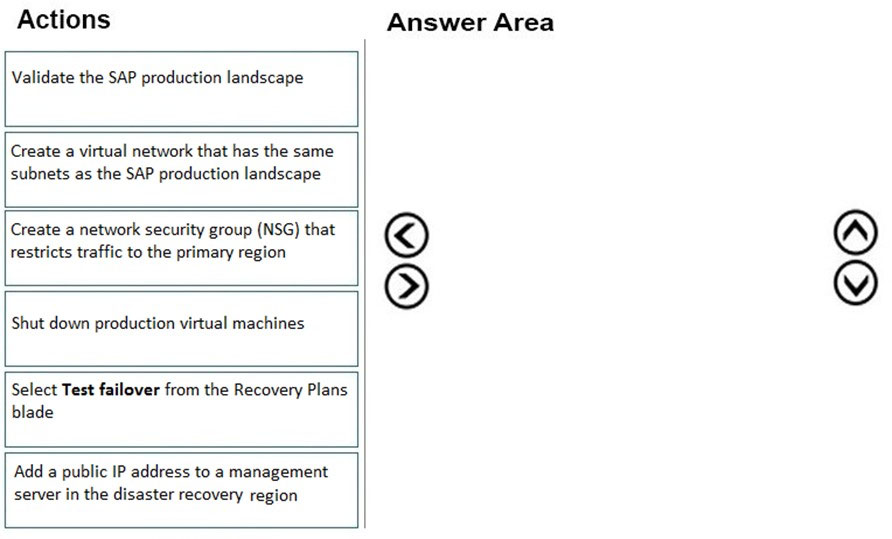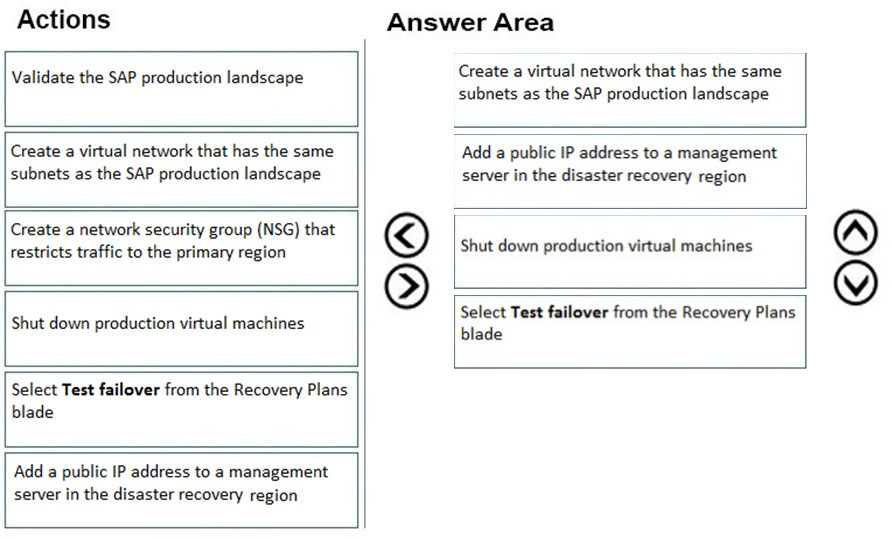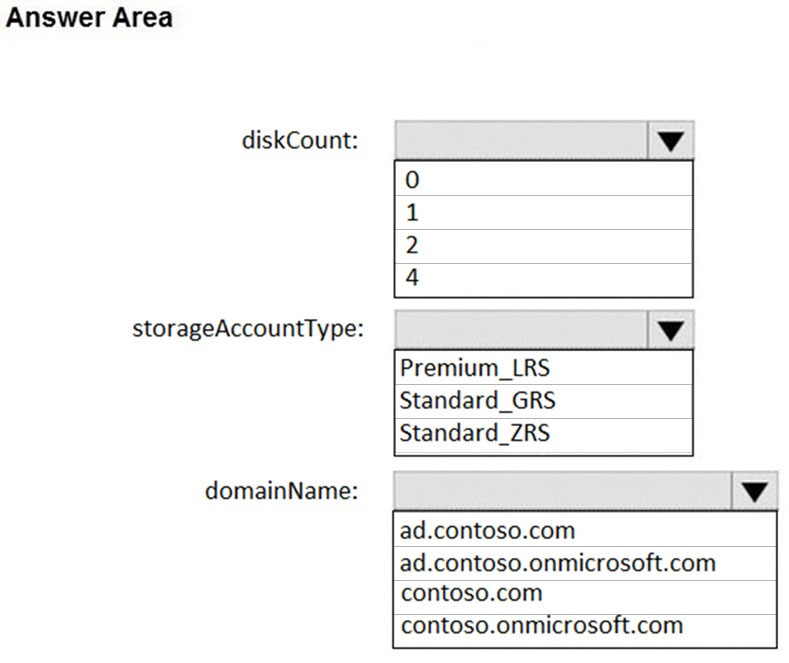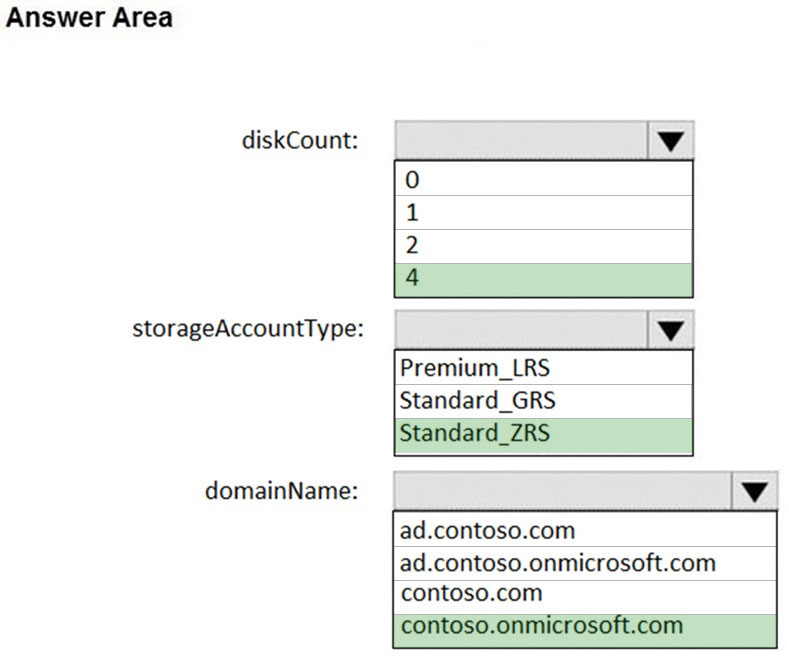AZ-120 Practice Questions Free – 50 Exam-Style Questions to Sharpen Your Skills
Are you preparing for the AZ-120 certification exam? Kickstart your success with our AZ-120 Practice Questions Free – a carefully selected set of 50 real exam-style questions to help you test your knowledge and identify areas for improvement.
Practicing with AZ-120 practice questions free gives you a powerful edge by allowing you to:
- Understand the exam structure and question formats
- Discover your strong and weak areas
- Build the confidence you need for test day success
Below, you will find 50 free AZ-120 practice questions designed to match the real exam in both difficulty and topic coverage. They’re ideal for self-assessment or final review. You can click on each Question to explore the details.
You plan to migrate an SAP environment to Azure. You need to create a design to facilitate end-user access to SAP applications over the Internet, while restricting user access to the virtual machines of the SAP application servers. What should you include in the design?
A. Configure a public IP address for each SAP application server
B. Deploy an internal Azure Standard Load Balancer for incoming connections
C. Use an SAP Web Dispatcher to route all incoming connections
D. Configure point-to-site VPN connections for each user
You have an on-premises SAP NetWeaver deployment that uses Windows Server 2016 and Microsoft SQL Server 2016. You need to migrate the deployment to an Azure virtual machine that runs Windows Server 2016 and has Microsoft SQL Server 2019 installed. Which migration method should you use?
A. lift-and-shift
B. Azure Migrate
C. classical SAP Database Migration Option (DMO)
D. heterogeneous SAP classical migration
DRAG DROP - Your on-premises network contains an Active Directory domain. You are deploying a new SAP environment on Azure. You need to configure SAP Single Sign-On to ensure that users can authenticate to SAP GUI and SAP WebGUI. Which four actions should you perform in sequence? To answer, move the appropriate actions from the list of actions to the answer area and arrange them in the correct order.
You have an Azure subscription that contains an SAP HANA on Azure (Large Instances) deployment. The deployment is forecasted to require an additional 256 GB of storage. What is the minimum amount of additional storage you can allocate?
A. 256 GB
B. 512 GB
C. 1 TB
D. 2 TB
DRAG DROP - You have an Azure subscription that contains an availability set named AS1 and a virtual machine named VM1. VM1 hosts an SAP NetWeaver application. You need to ensure that AS1 includes VM1. Which four PowerShell cmdlets should you run in sequence? To answer, move the appropriate actions from the list of actions to the answer area and arrange them in the correct order.
You plan to migrate an on-premises SAP development system to Azure. Before the migration, you need to check the usage of the source system hardware, such as CPU, memory, network, etc. Which transaction should you run from SAP GUI?
A. SM51
B. DB01
C. DB12
D. ST06
DRAG DROP - You have an SAP ERP Central Component (SAP ECC) deployment on Azure virtual machines. The virtual machines run Windows Server 2022 and are members of an Active Directory domain named contoso.com. You install SAP GUI on an Azure virtual machine named VM1 that runs Windows 10. You need to ensure that contoso.com users can sign in to SAP ECC via SAP GUI on VM1 by using their domain credentials. What should you do? To answer, drag the appropriate components to the correct tasks. Each component may be used once, more than once, or not at all. You may need to drag the split bar between panes or scroll to view content. NOTE: Each correct selection is worth one point.
DRAG DROP - You plan to deploy multiple SAP HANA virtual machines to Azure by using an Azure Resource Manager template. How should you configure Accelerated Networking and Write Accelerator in the template? To answer, drag the appropriate values to the correct targets. Each value may be used once, more than once, or not at all. You may need to drag the split bar between panes or scroll to view content. NOTE: Each correct selection is worth one point. Select and Place:
HOTSPOT - You have an on-premises SAP NetWeaver deployment that runs SUSE Linux Enterprise Server (SLES). The deployment contains 200 GB of files used by application servers stored in an NFS share. You plan to migrate the on-premises deployment to Azure. You need to implement an NFS storage solution. The solution must meet the following requirements: • Ensure that only the application servers can access the storage. • Support NFS 4.1 • Minimize costs. What should you include in the solution? To answer, select the appropriate options in the answer area. NOTE: Each correct selection is worth one point.
HOTSPOT - You are planning the deployment of a three-tier SAP landscape on Azure that will use SAP HANA. The solution must meet the following requirements: • Network latency between SAP NetWeaver and HANA must be minimized. • An SAP production landscape on Azure must be supported. • Network performance must be validated regularly. What should you include in the solution? To answer, select the appropriate options in the answer area. NOTE: Each correct selection is worth one point.
You have an SAP environment on Azure. Your on-premises network uses a 1-Gbps ExpressRoute circuit to connect to Azure. Private peering is enabled on the circuit. The default route (0.0.0.0/0) from the on-premises network is advertised. Whenever backups are copied to Azure Blob storage, the ExpressRoute circuit is saturated. You need to resolve the issue without modifying the ExpressRoute circuit. The solution must minimize administrative effort. What should you do?
A. Create a user-defined route that redirects traffic to the Blob storage
B. Create an application security group
C. Change the backup solution to use a third-party software that can write to the Blob storage
D. Enable virtual network private endpoints.
You have an on-premises SAP landscape that is hosted on VMware vSphere and contains 50 virtual machines. You need to perform a lift-and-shift migration to Azure by using Azure Migrate. The solution must minimize administrative effort. What should you deploy first?
A. an Azure Backup server
B. an Azure VPN gateway
C. an Azure Migrate configuration server
D. an Azure Migrate process server
HOTSPOT - You have an on-premises deployment of SAP HANA. You plan to migrate the deployment to Azure. You need to identify the following from the last six months: ✑ The number of active users ✑ The database performance What should you do? To answer, select the appropriate options in the answer area. NOTE: Each correct selection is worth one point. Hot Area:
You are migrating SAP to Azure. The ASCS application servers are in one Azure zone, and the SAP database server in in a different Azure zone. ASCS/ERS is configured for high availability. During performance testing, you discover increased response times in Azure, even though the Azure environment has better computer and memory configurations than the on-premises environment. During the initial analysis, you discover an increased wait time for Enqueue. What are three possible causes of the increased wait time? Each correct answer presents a complete solution. NOTE: Each correct selection is worth one point.
A. a missing Enqueue profile
B. disk I/O during Enqueue backup operations
C. misconfigured load balancer rules and health check probes for Enqueue and ASCS
D. active Enqueue replication
E. network latency between the database server and the SAP application servers
You have an Azure subscription that contains 10 virtual machines. You plan to deploy an SAP landscape on Azure that will run SAP HANA. You need to ensure that the virtual machines meet the performance requirements of HANA. What should you use?
A. ABAP Profiler
B. SAP HANA Hardware and Cloud Measurement Tool (HCMT)
C. Azure Advisor
D. SAP Quick Sizer
DRAG DROP - You have an on-premises SAP environment that runs on SUSE Linux Enterprise Server (SLES) servers and Oracle. The version of the SAP ERP system is 6.06 and the version of the portal is SAP NetWeaver 7.3. You need to recommend a migration strategy to migrate the SAP ERP system and the portal to Azure. The solution must be hosted on SAP HANA. What should you recommend? To answer, drag the appropriate tools to the correct components. Each tool may be used once, more than once, or not at all. You may need to drag the split bar between panes or scroll to view content. NOTE: Each correct selection is worth one point. Select and Place:
HOTSPOT - You are planning the Azure network infrastructure for an SAP environment. For each of the following statements, select Yes if the statement is true. Otherwise, select No. NOTE: Each correct selection is worth one point. Hot Area:
HOTSPOT - For each of the following statements, select Yes if the statement is true. Otherwise, select No. NOTE: Each correct selection is worth one point.
You have an SAP environment that is managed by using VMware vCenter. You plan to migrate the SAP environment to Azure. You need to gather information to identify which compute resources are required in Azure. What should you use to gather the information?
A. Azure Migrate and SAP EarlyWatch Alert reports
B. Azure Site Recovery and SAP Quick Sizer
C. SAP Quick Sizer and SAP HANA system replication
D. Azure Site Recovery Deployment Planner and SAP HANA Cockpit
DRAG DROP - You need to connect SAP HANA on Azure (Large Instances) to an Azure Log Analytics workspace. Which four actions should you perform in sequence? To answer, move the appropriate actions from the list of actions to the answer area and arrange them in the correct order. Select and Place:
HOTSPOT - You have an SAP on Azure landscape. You need to gather the following metrics: • The network latency between an SAP NetWeaver server and an SAP HANA server. • The throughput and latency of the storage subsystem on Windows Server and Linux platforms. What should you use for each metric? To answer, select the appropriate options in the answer area. NOTE: Each correct selection is worth one point.
After you answer a question in this section, you will NOT be able to return to it. As a result, these questions will not appear in the review screen. You have a complex SAP environment that has both ABAP- and Java-based systems. The current on-premises landscapes are based on SAP NetWeaver 7.0 (Unicode and Non-Unicode) running on Windows Server and Microsoft SQL Server. You need to migrate the SAP environment to a HANA-certified Azure environment. Solution: You deploy a new environment to Azure that uses SAP NetWeaver 7.4. You export the databases from the on-premises environment, and then you import the databases into the Azure environment. Does this meet the goal?
A. Yes
B. No
You plan to deploy an SAP environment on Azure that will use Azure Availability Zones. Which load balancing solution supports the deployment?
A. Azure Basic Load Balancer
B. Azure Standard Load Balancer
C. Azure Application Gateway v1 SKU
You have an on-premises SAP NetWeaver application server and SAP HANA database deployment. You plan to migrate the on-premises deployment to Azure. You provision new Azure virtual machines to host the application server and database roles. You need to initiate SAP Database Migration Option (DMO) with System Move. On which server should you start Software Update Manager (SUM)?
A. the virtual machine that will host the application server
B. the virtual machine that will host the database
C. the on-premises database server
D. the on-premises application server
You have an existing SAP production landscape that uses SAP HANA databases. You plan to migrate the landscape to Azure. Which Azure virtual machine series will be Azure supported for the production SAP HANA database deployment?
A. F-Series
B. A-Series
C. M-Series
D. N-Series
You migrate an SAP environment to Azure. You need to inspect all the outbound traffic from the SAP application servers to the Internet. Which two Azure resources should you use? Each correct answer presents part of the solution. NOTE: Each correct selection is worth one point.
A. Azure Traffic Manager
B. Azure Firewall
C. Network Performance Monitor
D. Azure user-defined routes
E. Azure Load Balancer NAT rules
F. a Web Application Firewall (WAF) for Azure Application Gateway
DRAG DROP - You have a bill of materials (BOM) that describes SAP deployments. You plan to automate the implementation of an SAP S4/HANA deployment to Azure by using the SAP deployment automation framework on Azure. You need to generate the SAP application templates for the planned implementation and update the BOM. In which order should you perform the actions? To answer, move all actions from the list of actions to the answer area and arrange them in the correct order.
DRAG DROP - You have an SAP environment on Azure. You use Azure Recovery Services to back up an SAP application server. You need to test the restoration process of a file on the server. Which three actions should you perform in sequence? To answer, move the appropriate actions from the list of actions to the answer area and arrange them in the correct order. Select and Place:
You have an Azure subscription. You plan to deploy a virtual machine named VM1 that will have the following configurations: • Data disk size: 4 TB • Generation: Generation 2 • Data disk type: Ultra disk • Data disk encryption type: Double encryption VM1 will host the SAP global transport directory in a volume on the data disk. You need to ensure that you can replicate VM1 by using Azure Site Recovery. Which configuration should you change?
A. generation
B. data disk type
C. data disk encryption type
D. data disk size
HOTSPOT - You have an SAP on Azure production landscape that contains an SAP HANA database. You create a backup policy as shown in the following exhibit.Use the drop-down menus to select the answer choice that completes each statement based on the information presented in the graphic. NOTE: Each correct selection is worth one point.
You plan to migrate an on-premises SAP development system to Azure. Before the migration, you need to check the usage of the source system hardware, such as CPU, memory, network, etc. Which transaction should you run from SAP GUI?
A. SM51
B. DB01
C. DB12
D. OS07N
DRAG DROP - You have an on-premises SAP NetWeaver-based ABAP deployment hosted on servers that run Windows Server or Linux. You plan to migrate the deployment to Azure. What will invalidate the existing NetWeaver ABAP licenses for each operating system once the servers are migrated to Azure? To answer, drag the appropriate actions to the correct operating systems. Each action may be used once, more than once, or not at all. You may need to drag the split bar between panes or scroll to view content. NOTE: Each correct selection is worth one point.
HOTSPOT - For each of the following statements, select Yes if the statement is true. Otherwise, select No. NOTE: Each correct selection is worth one point.
You have a two-node SAP HANA cluster that is hosted on Azure virtual machines. Each cluster node uses Azure NetApp Files to store database files. The nodes replicate synchronously by using HANA system replication. You need to implement a backup solution for the HANA databases. The solution must meet the following requirements: • Be cluster aware. • Support the use of snapshots. • Ensure that backups are application consistent. What should you include in the solution?
A. AzAcSnap
B. the Az.NetAppFiles PowerShell module
C. Microsoft Azure Backup Server (MABS)
D. the azure_hana_backup command
You have an SAP landscape on Azure that uses SAP HANA. You perform a daily backup of HANA to Azure Blob Storage and retain copies of each backup for one year. You need to reduce the backup storage costs. What should you implement?
A. a stored access policy
B. a Recovery Services Vault backup policy
C. a storage access tier
You deploy an SAP environment on Azure. Your company has a Service Level Agreement (SLA) of 99.99% for SAP. You implement Azure Availability Zones that have the following components: ✑ Redundant SAP application servers ✑ ASCS/ERS instances that use a failover cluster Database high availability that has a primary instance and a secondary instanceYou need to validate the high availability configuration of the ASCS/ERS cluster. What should you use?
A. SAP Web Dispatcher
B. Azure Traffic Manager
C. SAPControl
D. SAP Solution Manager
HOTSPOT - For each of the following statements, select Yes if the statement is true. Otherwise, select No. NOTE: Each correct selection is worth one point. Hot Area:
After you answer a question in this section, you will NOT be able to return to it. As a result, these questions will not appear in the review screen. You have a complex SAP environment that has both ABAP- and Java-based systems. The current on-premises landscapes are based on SAP NetWeaver 7.0 (Unicode and Non-Unicode) running on Windows Server and Microsoft SQL Server. You need to migrate the SAP environment to a HANA-certified Azure environment. Solution: You upgrade to SAP NetWeaver 7.4, and then you migrate SAP to Azure by using Azure Site Recovery. Does this meet the goal?
A. Yes
B. No
You have an on-premises deployment of SAP on DB2. You plan to migrate the deployment to Azure and Microsoft SQL Server 2017. What should you use to migrate the deployment?
A. db2haicu
B. SQL Server Migration Assistant (SSMA)
C. DSN1COPY
D. Azure SQL Data Sync
HOTSPOT - You have an Azure AD tenant named contoso.com that syncs to an Active Directory domain hosted on an Azure virtual machine. You plan to deploy an SAP NetWeaver landscape on Azure that will use SUSE Linux Enterprise Server (SLES). You need to recommend an authentication solution for the following scenarios. The solution must support Azure Multi-Factor Authentication (MFA): • Administrators sign in to SLES Azure virtual machines. • A user signs in to an SAP NetWeaver application. What should you recommend for each scenario? To answer, select the appropriate options in the answer area. NOTE: Each correct selection is worth one point.
Your company has an on-premises SAP environment. Recently, the company split into two companies named Litware, Inc. and Contoso, Ltd. Litware retained the SAP environment. Litware plans to export data that is relevant only to Contoso. The export will be 1.5 TB. Contoso builds a new SAP environment on Azure. You need to recommend a solution for Litware to make the data available to Contoso in Azure. The solution must meet the following requirements: • Minimize the impact on the network. • Minimize the administrative effort for Litware. What should you include in the recommendation?
A. Azure Import/Export service
B. Azure Migrate
C. Azure Data Box
D. Azure Site Recovery
You migrate an on-premises instance of SAP HANA to HANA on Azure (Large Instances). You project that you will replace HANA Large Instances with two smaller instances in two years. You need to recommend a solution to minimize SAP HANA costs for the next three years. What should you include in the recommendation?
A. Azure Hybrid Benefit
B. a one-year reservation that has capacity priority
C. a three-year reservation that has instance size flexibility
D. a one-year reservation that has instance size flexibility
DRAG DROP - You have an SAP environment on Azure. You use Azure Site Recovery to protect an SAP production landscape. You need to validate whether you can recover the landscape in the event of a failure. The solution must minimize the impact on the landscape. Which four actions should you perform in sequence? To answer, move the appropriate actions from the list of actions to the answer area and arrange them in the correct order. Select and Place:
HOTSPOT - You have an Azure subscription. You plan to deploy an SAP landscape. You need to configure an NFS cluster that will host the storage for the landscape. The solution must ensure that the cluster is available if an Azure datacentre fails. How should you configure the cluster? To answer, select the appropriate options in the answer area. NOTE: Each correct selection is worth one point.
HOTSPOT - You need to provide the Azure administrator with the values to complete the Azure Resource Manager template. Which values should you provide for diskCount, StorageAccountType, and domainName? To answer, select the appropriate options in the answer area. NOTE: Each correct selection is worth one point. Hot Area:
You have an SAP landscape on Azure that contains the virtual machines shown in the following table.You need to ensure that the Application Server role is available if a single Azure datacenter fails. What should you include in the solution?
A. a local network gateway
B. Azure Load Balancer Standard
C. Azure Virtual WAN
D. Azure Active Directory (Azure AD) Application Proxy
HOTSPOT - You deploy SAP HANA by using SAP HANA on Azure (Large Instances). For each of the following statements, select Yes if the statement is true. Otherwise, select No. NOTE: Each correct selection is worth one point. Hot Area:
HOTSPOT - For each of the following statements, select Yes if the statement is true. Otherwise, select No. NOTE: Each correct selection is worth one point.
DRAG DROP - You plan to deploy an SAP production landscape on Azure. The landscape will use SAP HANA databases that run on Azure virtual machines. Each HANA virtual machine will contain the following three premium data disks: • Shared • Data • Log You need to configure caching on the data disks. The solution must meet the following requirements: • Maximize data throughput. • Minimize potential data loss. Which caching configuration should you use for each disk? To answer, drag the appropriate caching configurations to the correct disks. Each caching configuration may be used once, more than once, or not at all. You may need to drag the split bar between panes or scroll to view content. NOTE: Each correct selection is worth one point.
You have an on-premises SAP AnyDB deployment hosted on an operating system that is NOT supported in Azure. You need to migrate the deployment to Azure by performing a replatform and migration to SAP HANA. The solution must meet the following requirements: • Minimize administrative effort. • Minimize downtime. What should you use?
A. Azure Migrate
B. Azure Database Migration Service
C. SAP Software Provisioning Manager
D. SAP Software Update Manager
Free Access Full AZ-120 Practice Questions Free
Want more hands-on practice? Click here to access the full bank of AZ-120 practice questions free and reinforce your understanding of all exam objectives.
We update our question sets regularly, so check back often for new and relevant content.
Good luck with your AZ-120 certification journey!


